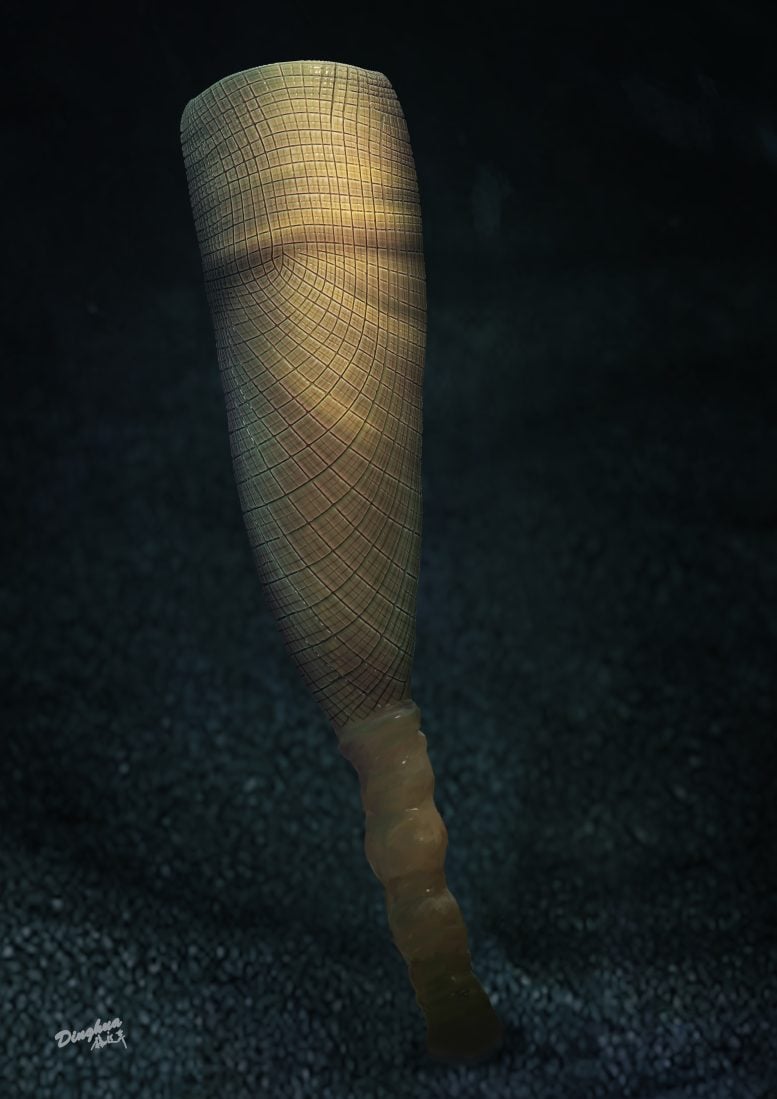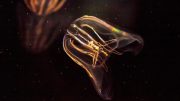
A groundbreaking discovery of a 550 million-year-old sea sponge fossil offers new insights into sponge evolution and guides future fossil searches. Reconstructed life position of Helicolocellus on Ediacaran seafloor. Credit: Yuan Xunlai
The research offers new insights into the early evolution of animals.
Researchers led by Shuhai Xiao at Virginia Tech have discovered a 550 million-year-old sea sponge fossil, shedding light on a 160 million-year gap in the fossil record. This fossil, which suggests early sponges lacked mineral skeletons, provides new insights into the evolution of one of the earliest animals and influences how paleontologists search for ancient sponges.
At first glance, the simple sea sponge is no creature of mystery. No brain. No gut. No problem dating it back 700 million years. Yet convincing sponge fossils only go back about 540 million years, leaving a 160 million-year gap in the fossil record.
In a paper released June 5 in the journal Nature, Virginia Tech geobiologist Shuhai Xiao and collaborators reported a 550 million-year-old sea sponge from the “lost years” and proposed that the earliest sea sponges had not yet developed mineral skeletons, offering new parameters to the search for the missing fossils.
The mystery of the missing sea sponges centered on a paradox. Molecular clock estimates, which involve measuring the number of genetic mutations that accumulate over time, indicate that sponges must have evolved about 700 million years ago. And yet there had been no convincing sponge fossils found in rocks that old.
For years, this conundrum was the subject of debate among zoologists and paleontologists.
This latest discovery fills in the evolutionary family tree of one of the earliest animals, explaining its apparent absence in older rocks and connecting the dots back to Darwin’s questions about when it evolved.
Xiao’s Groundbreaking Find
Xiao, who recently was inducted into the National Academy of Sciences, first laid eyes on the fossil five years ago, when a collaborator texted him a picture of a specimen excavated along the Yangtze River in China. “I had never seen anything like it before,” said Xiao, a faculty member in the College of Science. “Almost immediately, I realized that it was something new.”
Xiao and collaborators from the University of Cambridge and the Nanjing Institute of Geology and Paleontology began ruling out possibilities one by one: not a sea squirt, not a sea anemone, not a coral. They wondered, could it be an elusive ancient sea sponge?

Virginia Tech geobiologist Shuhai Xiao and collaborators reported a 550 million-year-old sea sponge fossil, filling in a gap in the evolutionary family tree of one of the earliest animals. Photo by Spencer Coppage for Virginia Tech. Credit: Spencer Coppage for Virginia Tech
In an earlier study published in 2019, Xiao and his team suggested that early sponges left no fossils because they had not evolved the ability to generate the hard needle-like structures, known as spicules, that characterize sea sponges today.
Xiao’s team members traced sponge evolution through the fossil record. As they went further back in time, sponge spicules were increasingly more organic in composition and less mineralized.
“If you extrapolate back, then perhaps the first ones were soft-bodied creatures with entirely organic skeletons and no minerals at all,” Xiao said. “If this was true, they wouldn’t survive fossilization except under very special circumstances where rapid fossilization outcompeted degradation.”
Later in 2019, Xiao’s international research group found a sponge fossil preserved in just such a circumstance: a thin bed of marine carbonate rocks known to preserve abundant soft-bodied animals, including some of the earliest mobile animals.
“Most often, this type of fossil would be lost to the fossil record,” Xiao said. “The new finding offers a window into early animals before they developed hard parts.”
New Fossil Discovery and Its Implications
The surface of the new sponge fossil is studded with an intricate array of regular boxes, each divided into smaller, identical boxes.
“This specific pattern suggests our fossilized sea sponge is most closely related to a certain species of glass sponge,” said Xiaopeng Wang, a postdoctoral researcher at the Nanjing Institute of Geology and Paleontology and the University of Cambridge.
Another unexpected aspect of the new sponge fossil is its size. “When searching for fossils of early sponges I had expected them to be very small,” said Alex Liu, a collaborator from the University of Cambridge. “The new fossil is about 15 inches long with a relatively complex, conical body plan, which challenged many of our expectations for the appearance of early sponges.”
While the fossil fills in some of the missing years, it also provides researchers with important guidance about how to search for these fossils — which will hopefully extend understanding of early animal evolution further back in time.
“The discovery indicates that perhaps the first sponges were spongey but not glassy,” Xiao said. “We now know that we need to broaden our view when looking for early sponges.”
Reference: “A late-Ediacaran crown-group sponge animal” by Xiaopeng Wang, Alexander G. Liu, Zhe Chen, Chengxi Wu, Yarong Liu, Bin Wan, Ke Pang, Chuanming Zhou, Xunlai Yuan and Shuhai Xiao, 5 June 2024, Nature.
DOI: 10.1038/s41586-024-07520-y









Am I really supposed to belive all that? Claims like this are two a penny and almost invariably get quietly dropped a little later when once again get disproven.
No, you are not supposed to read scientific literature unless you are interested in nature.
Fossil finds are rarely mistaken.
R.B. mystery of past earth is just interesting to discover ✨. Theory or truth 🤔 its discovery 🧠🕵🏻♀️
Rolf Burnie, I bet you’re fun at parties.
I just Rolf’d up the sushi I got at the gas station. Note to self gas station sushi bad idea…
Extraordinary story on past evolution discovery.
I am always waiting for evaluation factors such as petrificatin evolving from sedimentation factors caused from earthquake, volcanic eruption, natural catastrophic and such!
Extraordinary story on past evolution discovery.
I am always waiting for evaluation factors such as petrificatin evolving from sedimentation factors caused from earthquake, volcanic eruption, natural catastrophic and such!
550 million year old, funny seeing that the earth is only about 6,000 years old. Science doesn’t prove anything, but our ignorance. When you strip science back to it’s beginning there is nothing and something has never come from nothing. Life has always begot life. So it all goes back to “In the beginning God.” He is the beginning and the end. Science simply affirms God. Science can only give us the elemental process but never the source of intelligent design and perfect creation. This is what makes the word of God’s power superior to the intellect of man’s finite understanding. I stand in awe of The YHVH.
For Johnathan, the irony is what you “personally hate” you do yourself. You are quick to assume it’s “organized religion” when in fact it’s an individual. It would be enlightening to hear you describe how something came from nothing, how space time and matter appeared instantly, how consciousness “evolved”.while you attribute your existence to chance and time,a stinky sphincter, others ascribe to existing due to an All loving and powerful creator God who spoke everything into existence. Until you can prove otherwise all are welcome to their opinions. God bless you
“something has never come from nothing”
6,000-Year-Cretinism came from nothing; claim falsified, quod erat demonstrandum.
Your superstition besides, science is useful – it developed the transistor technology that makes this website possible.
Considering that we since 2016 have robustly and beyond reasonable doubt observed the entirely natural process of space expansion that produce the universe (c.f. “Scale factor (cosmology)”, Wikipedia), our finds reject the existence of any significant magic involved. E.g. your ‘gods’ seem non-existent.
Funny how religion always makes an appearance and as always it sounds ignorant and rude. Yes this is an opinion but just like all opinions they are like sphincters they are smelly and unwanted. I personally hate it when organized religion has an opinion due to the fact that it usually condemns anything out of its ideology.
For Johnathan, the irony is what you “personally hate” you do yourself. You are quick to assume it’s “organized religion” when in fact it’s an individual. It would be enlightening to hear you describe how something came from nothing, how space time and matter appeared instantly, how consciousness “evolved”.while you attribute your existence to chance and time,a stinky sphincter, others ascribe to existing due to an All loving and powerful creator God who spoke everything into existence. Until you can prove otherwise all are welcome to their opinions. God bless you
Jospeh, no doubt the superstition displayed here derives from organized superstition. E.g. only for religion does ‘nothing’ makes sense since it is untestable and does not exist – all we see is something.
The rest of questions and characterizations have nothing to do with the existence of persons that spam superstition on science sites, for no good reason. It only serves to show how immoral and weak superstition is, there is no ‘love’ or ‘power’ in it.
Rolf, why do you say that?
This article sounds promising to me. 550 million years ago puts this in the Ediacaran Period, where animals had no hard parts, sometimes had fractal structures (like boxes within boxes), and were, unlike this fossil, very hard to connect to their Cambrian period descendants.
For Johnathan, the irony is what you “personally hate” you do yourself. You are quick to assume it’s “organized religion” when in fact it’s an individual. It would be enlightening to hear you describe how something came from nothing, how space time and matter appeared instantly, how consciousness “evolved”.while you attribute your existence to chance and time,a stinky sphincter, others ascribe to existing due to an All loving and powerful creator God who spoke everything into existence. Until you can prove otherwise all are welcome to their opinions. God bless you.
Well done Shuhai Xiao and team for identifying a sea sponge which fills a gap in the fossil record. However “filling in a gap in the evolutionary family tree of one of the earliest animals” as Spencer Coppage suggests requires DNA information which is not present here. “…connecting the dots back to Darwin’s questions about when it evolved” doesn’t need DNA support but has no place in modern science.
Technically you don’t fill gaps in a gappy record, you increase the evidence and detail.
The find did support the genome dating, so I don’t understand your problem there. There are three pillars of evolution, the biogeographical record (descendants spread from an ancestral site), the morphological record as here (traits of fossil record) and the genetic record (where we have modern data). They did use “Poriferan inter-relationships following recent molecular phylogenies” when constraining their trait matrix, see the Supplementary material, so it is a mixed data approach.
Science once again closes the gap of understanding the dim past of this ecosystem world we live upon . The created idea of a man made dieity subject to change and ultimate dissolution takes a back seat. I send credence and recognition to the diligent scientist with great knowledge and precise tools to see the past frozen in rock.
Lawrence Morello crack up post, too right
Joseph! Yes! well said. It’s all kind of perfect if you think about it. Mad world
Joseph! Yes! well said. It’s all kind of perfect if you think about it. My mind is just exploding with the actual possibilities. Crazy times
If everyone just actually let go of their preconceptions and tried to make sense of everything just even by being open to possibilities and adding to your knowledge base, things start to fall into place on its own and in such a miraculous way that you end up where I am which is still trying to make sense of it all being raised in an atheist/scientific family and that having made sense to me as the true reality my whole life up until just recently. What you see around you is so hard to deny but there is some kind of invisible force inside everyone that indicates its existence in your own consciousness. It’s your conscience and instinct. Don’t get me wrong I am no way where I need to be yet. The philosophy I have for living isn’t how I live I should say.
Interesting times, interesting stuff.
Unless you’re all just a figment of my imagination. Maybe it’s both that and a real tangible reality who knows. I feel like we will find out though.
We don’t want to be so openminded that our brains fall out.
Science is openminded about the data, and so are its interested layperson followers.
But you do you.
Wow, I have a sea sponge that was fossil into a multilayer roll. Didn’t know what it was until I left it out in the snow, it separated and you could see the little squares. I’ve had it for over 40 years before I knew what it was.
If the world 🌎 is only 6000 how do you explain the dinosaurs fossils? And who made that up saying that is how old the earth is. The earth has been here millions of years.
Wow, every war has been fought for God, or oil. Leave Jonathan he has a right to his opinions. You’re very, hypocritical, don’t agree? Then move along to a book, why are you “Christians” so judgemental & downright cruel.
Quite some find!
And the paper is convincing. Even the phylogenetic placement is good enough considering the difficulties with the stem placements, and the morphological consistency with Devonian sponges looks good (for a non-expert). It is noteworthy that this and some other sponges have fractal-like patterns, akin to the early frond animals.
The paper doesn’t hypothesize on the reason for (apparently independent) evolution of mineralization in sponges, but increased predation pressure from moving animals would be a simple one.